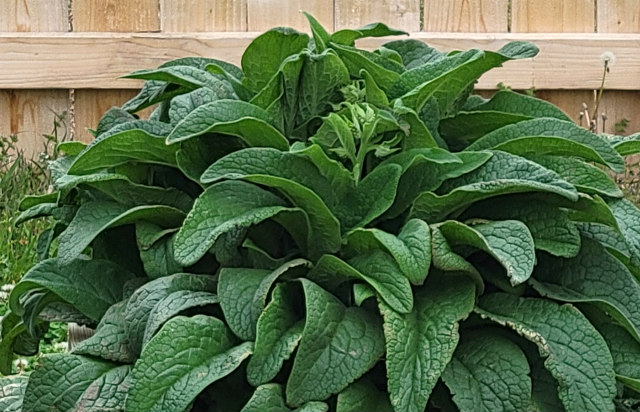Comfrey is a powerful herb with some amazing benefits. You can buy the dried herb at health stores, but why not grow your own comfrey for a never-ending supply? Here are 5 uses for comfrey and why it's worth growing your own.
Why you should grow comfrey in your garden
While a comfrey plant can take up a lot of space in your garden, the benefits of comfrey far outweigh the room it requires.
My largest and oldest comfrey plant takes up most of the end of one of my 3' x 8' raised garden beds, measuring almost 3 feet across. I brought this plant from our larger homestead when we moved, and it is descended from my original comfrey plant that I purchased in 2015.
It's a plant I don't want to be without!
Here are five reasons you might want to grow comfrey in your own garden too.
Medicinal uses for comfrey
Comfrey is also known as "knitbone" and "bone-set." It contains allantoin which heals connective tissue. It's amazing medicine on cuts, scrapes, swelling and rashes, and also is said to speed healing of broken bones.
I've made comfrey salve (you'll find my comfrey salve recipe here) and I've also added comfrey to the usual plantain/yarrow/lemon balm infused oil and salve that we use for scratches, rashes and other skin issues.
This year I've combined comfrey infused oil with ginger and purple dead nettle for a pain-relieving salve for arthritis.
Years ago I used a comfrey-infused oil (without beeswax so it wasn't a salve) to rub on one of our young horses where she'd cut her face above her eye. The cut healed up perfectly without even a scar.
I also used infused oil on one of my barn cats, Bullet, who had a persistently-raw sore behind one ear. Whenever it began to scab over and heal, he'd scratch it again with the claws on his hind foot, re-opening the sore and starting the process all over.
Comfrey salve didn't stick to his skin and fur very well, so I used the same infused oil as I'd used on my horse. The comfrey oil made great improvements on Bullet's wound and it healed up quickly. The oil "sticks" better to fur than salve or ointment does.
Another way to use comfrey medicinally is as a poultice on wounds.
The leaves are mashed up (or you can put them in a blender with a bit of water to make a thick paste) and spread over the affected area. Cover with a cloth or with plastic wrap to hold it on if needed.
In the fall before my plants die back, I harvest fresh leaves and store them in the freezer over the winter, just in case we need to use them as a poultice. If we don't use them, I add them to the compost pile in spring.

Compost accelerator
Bury fresh comfrey leaves in your compost pile. They'll quickly heat up and activate your compost.
There are always some dead leaves around the base of my comfrey plants, so every so often I pull those off and add them to my compost pile too.
Comfrey tea fertilizer
Comfrey tea is a marvelous, effective fertilizer for your garden plants. Brew some comfrey tea (click the link for the directions), then dilute it and water your plants with it.
This tea is for your garden, not for you to drink!
Comfrey benefits the soil
Comfrey sends its long roots deep down into the soil and mines the minerals that lay deep below the surface, bringing them up where your other plants can access them.
You can also lay comfrey leaves on the soil around your garden plants. This green mulch will enrich the soil and feed your plants by releasing the minerals stored in its leaves while it blocks weeds.
Related post: How to Grow Comfrey
Comfrey as livestock feed
Comfrey is a good source of feed for sheep, pigs, cattle, chickens, ducks, horses and other animals. Dried comfrey has a very high protein content.
I also offer a few fresh leaves as a treat to my goats. Some people say that their goats don't like comfrey but mine fight over it, both fresh and dried.
Before feeding comfrey to your livestock, research the pyrrolizidine alkaloids contained in comfrey so you can make an informed decision on the amount to feed your livestock. (Keep reading for more information about this.)
Comfrey attracts pollinators
A bonus reason to grow comfrey is that their flowers attract pollinators. In the spring comfrey develops flower stalks with pretty purple blooms that attract bumblebees and honeybees.
Is comfrey illegal?
Growing comfrey is not illegal in the United States.
However there is some controversy that comfrey taken internally might be dangerous. Comfrey contains pyrrolizidine alkaloids that could damage the liver.
For this reason, comfrey products for internal consumption are no longer available for sale in the United States and other countries.
However, comfrey is popularly used topically (applied to the skin).
Should you grow comfrey in your own garden?
Comfrey is a space hog, but it's well worth the space it requires. Be sure to give it plenty of room to spread out in your garden. Here's how to grow comfrey.
I think every garden needs a comfrey plant or two, for its many benefits and contributions.
For more homesteading and self-sufficient posts, subscribe to The Acorn, Oak Hill Homestead's newsletter, and follow me on Facebook, Instagram and Pinterest. I'd love to see you there!















